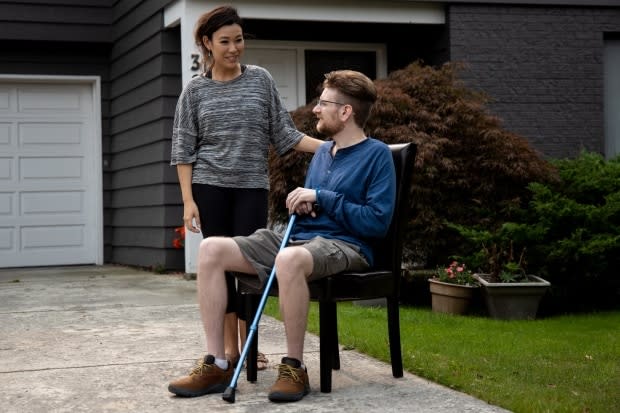Chronic pain patients suffer as treatments delayed due to pandemic
For David Ellis, even the most seemingly innocuous sensations can be excruciating. The feeling of clothes touching his skin, or even his feet touching the ground can bring him severe pain.
The 34-year-old suffers from fibromyalgia and chronic fatigue syndrome. It took five years for Ellis to be properly diagnosed with what are often referred to as the "invisible illnesses" — and just a year and a half ago he found treatment that worked for him.
Ellis normally receives lidocaine infusions at St. Paul's Hospital every four weeks. The anesthetic is injected into the fat of his abdomen and numbs his nerves and relaxes his muscles, allowing him to do basic things like brush his teeth.
"It helps block those pain signals … and it allows me more functionality. With it I'm able to get out of the house a bit more, do a bit of exercise, a little bit of walking," he said of the treatment, which provides a degree of relief for about three weeks.
But due to the pandemic and physical distancing rules at the hospital, he isn't able to get the treatment as frequently as before. He used to go in every four weeks — now it's every seven weeks.
"Without it for long periods of time I become overwhelmed by pain, bone-crushing fatigue that is indescribable and unimaginable by most people, there is nothing I can really do about it. There are no medications that help. I just have to lay in bed and rest and wait for the symptoms to lessen a little bit."

Pre-COVID, the Interventional and Complex Pain Clinic at St. Paul's Hospital had capacity for seven or eight subcutaneous lidocaine treatments per day. Now it can accommodate four or five.
In a statement, a spokesperson for the hospital said it "triages and schedules patients for treatment according to the urgency of their condition," adding that it's planning to increase access to services — "including new partnerships with physicians to offer virtual support and infusion therapy for patients in more settings."
Maria Hudspith, executive director of Pain B.C., a charitable organization that aims to enhance the lives of those living with chronic pain, says access to all kinds of pain management treatments have been disrupted since the start of the pandemic.
"It might be medication or interventions but it's also things like physiotherapy, going to the pool, going to the community centre for a gentle movement class … all of those kinds of treatments have been disrupted because of COVID and we've certainly seen significant numbers of people who live with pain, facing increasing distress and definitely increasing disability," she said.
Hudspith said they're working with provincial governments and health authorities to provide a provincial strategy for addressing chronic pain, adding that there are limited services available at the moment.
"We really only have a handful of publicly funded pain clinics in our province, a number of other ones that are privately funded and provide services under MSP, but when you think [that] chronic pain affects one in five people in the population, we do not have the degree of services we need to address this," she said.
As for Ellis, he worries treatments will be even more staggered as the fall approaches. In the meantime, he says there is nothing he can do but manage his activity level to ensure he doesn't overexert himself as he waits for his next appointment.

